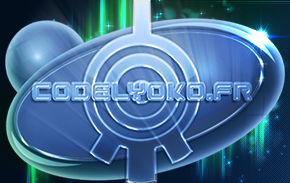
|
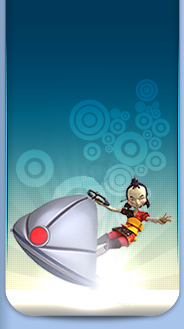 |
Tron Legacy
| | | Sources of inspiration of Code Lyoko
“Tron Legacy”
Let's get started with a major part of Code Lyoko's sources of inspiration! It was acknowledged as such by Code Lyoko's writers, and by Tania Palumbo and Thomas Romain (the creators of Garage Kids), and its influence was notably spotted by the French Wikipedia, which resulted in the following expression: “Tron Legacy”
Which is precisely the subject of this page!
Though this page may seem unattractive, I testify that any proper Lyokofan should know a little more about Tron.
So, what is Tron, nutshell version!
Tron is a movie that was made in the 80's, using CGI and photoshopping for the first time! Well, those who are really keen on recent special effects and scenes in which everything happens very fast may not find what they are looking for; nevertheless, Tron is an essential step in the history of CGI, as well as science-fiction!
This movie can be referred to as a groundbreaking achievement! Remember, in 1980, video games were played on the Atari and Commodore, or in arcades – in other words, they were still at an embryonic stage! Hence the (very modern) kind of flippers that famous gamers use during the movie, instead of gamepads connected to consoles.
As for the title “Tron”, it is the name of one of the characters, though it's not the main protagonist's. Indeed, Tron is not human: it's a program, that lives inside a computer, and can access the network. Doesn't that already remind you of our little Aelita? Well, don't get carried away! Even though it is an intelligent being, Tron was never human: it is 100% artificial intelligence. Which doesn't imply that there are no similarities, on the contrary! For instance, their purpose? Resetting it all!
Without delay, let's discover some information about the film...
Title: Tron
Directed by: Steven Lisberger
Story by: Steven Lisberger and Bonnie MacBird
Produced by: Donald Kushner, Harrison Ellenshaw and Ron Miller
Studio: Walt Disney Productions
Budget: $17 million
Music: Wendy Carlos
Cinematography: Bruce Logan
Editing by: Jeff Gourson
Art Department: Jean Giraud, Syd Mead and Dean Edward Mitzner
Costumes Department: Eloise Jensson, Rosanna Norton and Lorry Richter
Country: United States
Genre: Science-fiction
Run time: 96 minutes
Release dates: 9 July 1982 in the United States, 8 December 1982 in France
Source: Wikipedia
Well, in case you don't have the time to watch the movie, here is a short synopsis.
In 1982, a big company, ENCOM, created a whole universe in a video game: Space Paranoids. This masterpiece is the outcome of the whole company's work, but it mostly exists thanks to one man: Kevin Flynn!
However, one of Flynn's coworkers, Edit Dillinger, double-crosses him, seizes his project, closes off all his access to his working files, and pretends to be the creator of this incredible game! He achieves such fame that he becomes ENCOM's CEO.
Nevertheless, Flynn is not one to easily give up. With the help of two friends, who are still employees at ENCOM (Alan Bradley and Lora), he will break into his old company's place at night, in order to free Tron. Tron is a revolutionary and autonomous program, retained captive, yet able to disable the security centre long enough for Flynn to get the documents proving that he is the creator of the game, which are heavily guarded.
However, the security program, called the MCP (Master Control Program), is the ultra-powerful puppet of its programmer, Dilligner.
A puppet? Actually, not quite! The very evening when Flynn tries to carry out his coup, the MCP, which is getting more and more intelligent, breaks its reins and turns out to be a threat. Dillinger has lost all control over it!
When Flynn attempts to free Tron, the MCP refuses to see a potential enemy program like Tron wandering around! It therefore use a laser, at the cutting edge of technology, to virtualise Flynn onto ENCOM's Network, where it is sure that taking him down will be easy.
In the rest of the movie, Flynn manages to escape the MCP's minions. Since he created most of the Network in which he manoeuvres, in particular the gaming platforms (Space Paranoids) where the MCP intended to suppress him, he manages to survive.
Flynn then meets Tron and other partners (programs rising up against the MCP's tyranny); together, they find a program able to destroy the MCP. So they go and fight the terrifying Master Control Program and its lieutenant: Sark, another of Dilliger's programs.
Flynn breaks into the MCP and allows Tron to destroy it using the program. The human thus made possible the emancipation of the virtual world, and the destruction of the MCP. When the latter disappears, Flynn is automatically sent back to the real world, through the same laser that had virtualised him.
As a bonus, the gets the document proving that he is the one who created Space Paranoids, and all the glory it entails.
So this is what you need to know to understand the file:
Flynn: Creator of a famous gaming platform (Space Paranoids) who was robbed of his rights by Dillinger. He wants to use Tron in order to get around the MCP and get back the file proving that he is the one who created the game. He is unwillingly virtualised by the MCP and has to make his way to survive the virtual universe!
Dillinger: Usurper who stole the title of creator of Flynn's Space Paranoids, he still remains a brilliant programmer since he created the MCP. Though he is a key element of the plot, his role during the movie is more that of an extra, since he doesn't participate the action much.
MCP (Master Control Program): Extremely intelligent security system of the ENCOM company, it gets more and more clever, and rebels against Dillinger. It tries to exterminate anyone who can oppose it – in other words, Tron and Flynn.
Tron: Security program intended to protect ENCOM independently from the MCP. It is the only program that can get around the MCP, which makes it MCP's Enemy N°1.
Alan Bradley: Tron's creator, and Flynn's friend, he helps him to be acknowledged as the creator of Space Paranoids.
Sark: Program bound to the MCP; it makes sure its master's orders are executed in the digital world. Also programmed by Dillinger.
Well, you are ready to face the challenge of going through this long file, so now...let's really get started! | | |
 | I) Two series; two real worlds, but above all, two virtual universes! | |
|  | A] The real worlds!
a) Earth as we know it...
There isn't much to say about the real universes of these two series.
On one hand, Code Lyoko shows junior high school students who spend most of their time at school, and go to an abandoned factory every time the world is in danger.
On the other hand, Tron shows us the world of adults. There is not a single child in the movie (while there is a scene in which women in underwear are quite...plentiful). Advanced programs are created in broad daylight, by a major computing company that works on revolutionary projects.
Code Lyoko and Tron seem to take place in two very different contexts...
However, there is a similarity between these two real worlds.
First, these worlds are both contemporary at the time when Tron and Code Lyoko were created. I mean, Tron takes place in the 80s, and Code Lyoko around 2004-2005. And that's not all...
b) ...with over-advanced technology!
In these two real worlds, computing technology is way ahead of its time! And I do emphasise on the words: “of its time” Why? Because if you watch Tron from the perspective of an adolescent from the third millennium, some of its technology will seem out of fashion to you. Especially those famous racing games using flippers! Graphics sure are far from our beautiful Wii... **Notices Sony fans sharpening their knives** ...or our dear Playstation 3...
**Stands aside while Sony and Nintendo fans fiercely battle!**
But keep in mind that in 1980, video games were still at an early stage. So to the people of the 80s, Tron was showing an incredible revolution (that still hasn't stopped, even today...)
An anecdote to help you understand how those graphics were perceived at the time: during an awards ceremony, the movie Tron was not accepted into the “Special Effects” category. The reason? Well, directors had used computers! Nowadays, special effects without computers sounds crazy; at the time, it was the other way around.
As for Code Lyoko, less explications are needed: you already know that Supercomputers exist, but that they are far from having the same kind of power as Hopper's!
What's more, both the return to the past and virtualisation remain impossible. Well, some people say that they are possible, but anyhow, they'd require massive amounts of energy, far beyond what we have at our disposal.
See MisterGui's file for more precise explanations about the possibility of Lyoko's existence.
I could keep saying how amazed I am at Tronian avant-gardism and Lyokoian avant-gardism, but I don't want to take away your pleasure when you see the movie and find all the differences in viewpoints by yourself, resulting from the two decades that separate Tron and Code Lyoko.
Just...one last remark!
In the movie Tron, Alan Bradley, Tron's programmer, declares at some point that one day, machines will think by themselves. At the time when Tron was released, it sounded really inconceivable. Outside of Asimov's stories, there were not many people who'd fancy themselves chatting with their washing machine one day.
Nowadays, Artificial Intelligences have already been created, and even though they don't have XANA or MCP's abilities, there are few people who still doubt that one day, human beings will be able to create AIs that will be more intelligent than humans. Some people even see there a possibility of humanity's decline and its replacement by machines. And that's The Matrix! Incredible, those three universes really do match, don't they?
What, carried away? Who? Me?
B] The Virtual Worlds!
a) The world...
From our perspective, the world from Tron is very difficult to conceive. In a few decades, the public's understanding of computing underwent a remarkable evolution; what's more, as Lyokofans, we are influenced by Lyoko's portrayal of a digital world.
Therefore, do understand that the representation of Tron's world is not official nor complete.
Since this movie has been a little forgotten since 1982, I'd better explain what Tron's world looks like. First of all, the world of Tron better resembles the real world than Lyoko: no Desert, Mountain, Forest or Ice Sector. It rather looks like an endless city: main roads, walls, buildings, vehicles, game arenas, armed forces...
The Network's appearance is more material than digital. In Code Lyoko, when there is an explosion, the environment flickers for a while and then reappears. However, in Tron, if a bike crashes into a wall, the wall is cracked like it would be in real life; and contrary to what happens in Lyoko, the damage is not automatically repaired.
In this world, each computer's mainframe is a city, and each program is an individual fulfilling their job.
Tron takes place in the computer system of the ENCOM company, which is therefore represented as some kind of digital conurbation (set of cities linked together) composed of all the connected mainframes of the company's computers.
The network is a great number of digital cities that are connected with each other solely by long highways. Therefore, a city can cut itself off from the rest of the network by shutting off its accesses. A computer with no access to the internet would be a city with all its incoming and outgoing accesses shut, and no possible exchange with any other city.
This Tronian representation perfectly fits the words “Web” or “Net”! The network is a large spider web that links together all the computers in the world.
Still in a Tronian perspective, anyone who wants to get in a system has to try and get a program inside the computer to work for them. That's what Flynn first tries, at the beginning of the movie, since he doesn't know about Tron: he creates a program and tries to smuggle it into ENCOM's network, in order to get his documents.
Conversely, when ENCOM attacks, the MCP sends “fighting” programs to invade another city. Sark alludes to it when it is first shown. The “weaklings he has to attack” refer to the security systems of other digital towns (that represent, just to remind you, the circuits of a computer mainframe) or conurbations (networks).
One last question: what is there between the digital towns, and outside of the Web's highways?
Aha! But actually, it's simple. What is there between digital bubbles like Lyoko and the Replikas?
The Digital Sea!
Tron also has its own version of a digital ocean:
b) ...and its inhabitants.
Inside these cities (mainframes), every program serves a purpose. Well, one could say they're public servants.
For example, Sark is both an antivirus...and a virus. It can destroy foreign programs that break into ENCOM, or break into the security systems into which the company hacks. Those are its functions.
However, as a digital society, it could be seen as an instance of totalitarianism. Useless programs are exterminated! At best, they serve one last purpose before disappearing: entertaining people from the real world, as toys in a game arena – in other words, as gaming avatars! However, in Tron, programs have only one life, and no backup nor save can bring back to life a program that was eliminated during a game!
Another class of programs that are savagely destroyed are the system's enemies. At the time when Tron went out, those were not widely known, but you've surely heard of Trojan Horses or viruses. But it also applies to programs that are useless to the system. Basically, when you carelessly uninstall a program, delete its files, or clean up your hard drive, in Tron, the MCP deals with killing and eliminating the obsolete programs without notifying you.
But what really makes this digital dictatorship look like the real world is that in Tron, every program is personified: they are embodied by actors, in an appropriate costume. Therefore, looking at programs who think, talk with each other, feel pain and sadness and even kiss...all those human emotions make them fully-fledged live beings! It's as if unplanned artificial intelligences had already been created. Well, at least, as far as the most advanced programs are concerned: Tron, his “girlfriend”, the MCP and his lieutenant Sark...
We will come back to this interesting point in the next part. |  | |
 | II) Humans in a computer. From Digitisation to Virtualisation! | |
|  | A] Reminders and Comparison: the virtualisation and rematerialisation processes
a) Virtualisation et dematerialisation
Now we're getting to the main aspect that Code Lyoko and Tron share: the virtualisation process!
Developed by Hopper and his scanners in Code Lyoko, in Tron, it is the fruit of the work of a team composed of brilliant scientists, including Lora, one of Flynn's two allies.
It is lifelong teamwork that made possible the creation of a laser that would decompose matter. Just at the beginning of Tron, the team tries the laser on an orange, that they send to the digital world. However, since they don't even know about the existence of such a world in their computers, they just think they managed to make the orange disappear!
That's why they use the term “digitisation” instead of “virtualisation”.
While in Code Lyoko, virtualisation is two for a penny, only one virtualisation occurs in Tron – that is, Flynn's.
This virtualisation was intended by the bad guy of the story, to which we will come back later. Annoyed by Flynn's attempt to sabotage him from a real-world terminal, the MCP uses the laser beam, which was developed to experiment on objects. The effect, however, is no different: Flynn gets virtualised and changed into computer software.
Which was exactly what the MCP wanted, since it was certain that this getting rid of this annoying human would be a piece of cake, once he had been reduced to being a program.
Devirtualisation and rematerialisation are also pretty different from what we can see in Code Lyoko. In Tron, they consist in some totally unexplained serendipity that happens by chance, when Flynn sacrifices himself to immobilise the MCP, thus leaving it at Tron's mercy.
Nonetheless, these processes are still pretty similar in the series and in the movie.
See Korki's file to better understand and learn more about the virtualisation and materialisation processes in Code Lyoko.
The following is a series of comparison images, like I did for The Matrix. You will see, it is even closer in Tron than it was to The Matrix!
Not many remarks left, except that Flynn's virtualisation is less developed than the Lyoko Warriors'...
The scanning part is slower and requires the human body to be divided into little pieces: machines seem unable to scan and transfer in one whole piece.
Moreover, the whole process seems really fatiguing!
One last criticism: nothing explains how, once he has been changed into a program, Flynn retains his consciousness, his mind, his memories...Indeed, the body is virtualised, but what about the soul? Is the thinking data saved in an computer memory, as in Code Lyoko? But ENCOM's computers don't seem to be able to handle such an amount of data...
...a mystery...
With Lyoko, only rematerialisation is fatiguing, not the process that give you a digital form.
But before we get to the rematerialisation, we still have to go through devirtualisation and deresolution!
b) Devirtualisation/rematerialisation
Once inside the Digital World, Flynn is an exception. He's the only actual...errr...Network Warrior...of the movie, since he's the only digital character who came from the real world. He is, to a certain extent, an alien.
All the other inhabitants of the Network are programs. When they die, they have no body in which they can be rematerialised. They are more similar to XANA's monsters: their deaths in the digital word entails their immediate death.
The proper term would then be “deresolution”: devirtualisation that is not followed by rematerialisation.
But Krabs, Hornets and other creatures aren't the only ones who had to face such devirtualisations. Remember all the times when our heroes faced the same situation!
In episode #22 “Routine”, XANA hacked into the Supercomputer to make rematerialisation impossible!
In episode #61 “Sabotage”, it is the damage to the Supercomputer's components that makes devirtualisation deadly.
In episode #83 “Superstition”, a mandelbug endangers defeated Lyoko Warriors.
As soon as rematerialisation becomes impossible, our heroes must fight under a lot of pressure! Lyoko is not a “video game”, as Ulrich puts it (#17): their lives are at stake!
Not to mention the fact that Aelita underwent this situation during seasons 1 and 2. It's only after Hopper gave her back her missing fragment that Aelita became a full-fledged human who would be sent back to Earth after devirtualisation, instead of dying as a program in the digital world.
Not being able to rematerialise is very dangerous, and XANA knows it well! It even tries to cause this situation by attacking the scanners several times, in episode #7 “Image Problem”, using a fake Yumi, and again in episode #56 “False Lead”.
In this respect, when our heroes cannot be rematerialised, they really do become programs. If they were to be devirtualised, they would be lost forever, “derezzed” like many programs in Tron...
But let's get back to Flynn. As for the process of rematerialisation itself, it is the exact opposite of virtualisation, except there is no phase during which the body is scanned. Lora's laser retrieves program-Flynn's data, and brutally ejects them back into the real world, thus recreating the body.
Let's just point out that unlike virtualisation, Tron's rematerialisation is as quick and brutal as Code Lyoko's.
B] Virtual appearance
a) Virtual reality
The origin of our heroes' virtual avatars remained a mystery for quite a long time, until we learned that they were first defined by the analysis of the subconscious done by the Supercomputer, and that Jeremy could then modify them as he wished.
Therefore, even though they have the appearances of elves, geishas, samurais or giant purple cats, our virtualised heroes look like the teenagers they are in the real world. They retain their personalities because souls are encoded and saved in the Supercomputer's memory (by souls, I mean their memories and all that they are).
As such, we can assert that Lyoko is a very different world from ours. Humans who enter it remain themselves, but there are little other common points between Earth and Lyoko.
The Ice Sector pales in comparison to Greenland, and the Sahara is nothing like the Desert Sector...
The only actual inhabitants of Lyoko, that were born on Lyoko, have an immaterial form (like XANA), or were shaped by the imagination of their creator. Again, even if they share the same name, Krabs and crabs are as similar as a turnip and a beetroot.
In Tron, however, the Digital and Real worlds seem to be connected.
Flynn seems to bound by the same rules as our usual Lyoko Warriors; but I will talk about the programs, the ones that actually are from the digital world.
First of all, they are humanoids. Except for their sense of fashion and their whitish skins that are paler than a dead man's, they just look like our twins.
It is but a way to represent programs, but from the first scenes in ENCOM's mainframe, we do have the impression that a whole little human world dwells in our computers.
This detail is a radical divergence between the concepts of Tron and Code Lyoko.
Which Lyokofan wouldn't shoot a Kankrelat that would happen to be wandering around on a sports field without any hesitation? Surely none.
On the contrary, harming something that shares our human characteristics seems much more uncomfortable.
As for their behaviour, oddly, it is also pretty similar to ours.
There is a paradox in the movie. While they try to show that programs are not yet equal to human beings in terms of intelligence, on the other hand, programs are portrayed by human actors. Therefore, visually speaking, we tend to see those programs are our equals.
Some hints, however, set us thinking the contrary if we pay close attention. In the end, only the most advanced programs (including Tron and his nemesis, the MCP) are endowed with an intelligence close to human beings'.
Last element that draws the two worlds even closer to each other: the programs have the same physical appearance and the same behaviour as their user. In the film, the same actors portray a program and its creator!
For instance, Tron and Allan Bradley are played by the same person, as are Sark and Dillinger, and so on...
To make things even more mixed up, the programs' destinies are similar to that of their users! Indeed, sentiments begin to sprout up between two programs: Allan Bradley's program, Tron, and Lora's Yori. Funny, since the programmers are engaged in the real world!
But in the end, these parallel loves can be explained by the fact that each program has the same personality than their creator, whatever its function! So it is only logical that affinities are the same in both worlds.
To conclude, unlike Code Lyoko, in which the idea is dubious, Tron tries to describe a universe that truly is parallel to ours.
b) The programs' blood
There is an odd mystery surrounding the colour of the energy flowing through the programs' “veins”.
Initially, the colour is a cold, metallic blue, like the Digital Sea – actually, it could be the same substance. Therefore, it is likely that Tron's Digital Sea is some representation of virtual energy... A representation of electricity, maybe?
Yet, for some programs, there is a moment when the colour of this flow turns red. It seems to be somewhat linked with the MCP. However, we can only hypothesise about what this change of colour means and what caused it, because Tron's universe is pretty abstract at times. What's more, the fact that a program turns red doesn't mean that it is controlled by the MCP...
At one moment, when Flynn knocks out one of the MCP's minions, his flow turns red. Which doesn't seem to affect him whatsoever...
Just like the programs, the highways connecting computers together can also turn blue or red.
Which reminds us of Code Lyoko's Network (that is, the Digital Sea), the blue colour that becomes red when XANA is present!
|  | |
 | III) Code Lyoko! A descendant of Tron... | |
|  | ...that leaves a few references here and there!
A] Two similar stories: Tron, Code Lyoko's ancestor?
a) Existence of a virtual universe: to infinity and beyond!
Blatantly, this is the first common point. Though they are nothing alike.
Because Tron's digital world was not created or designed. It's more like an abstract representation of what's going on in our computers and on the Net that links them; thus, Tron's digital world would resemble the Network rather than Lyoko or a Replika.
If the conception of those who made the movie Tron was to be applied at Lyoko, Yumi, Ulrich, Odd, Aelita and William wouldn't be virtualised on our well-known Lyoko or in the Network: they would appear, as programs, inside a virtual city of phenomenal proportions representing the Supercomputer and all the programs inside it.
However, there is something that does closely resemble Lyoko in Tron...
Do you remember Ulrich's quote from the Prequel, “What if it's just some kind of giant video game?”?
Well, in Tron, games are the closest things to Lyoko. Usually, when users (or programmers) write programs, they don't even know anything about their appearances! Yet, there is a special category: the creators of video games, such as Flynn. They create game arenas connected to the real world, that humans can explore and in which they can enjoy themselves.
So, for each new video game, an new “arena” appears, in which everything looks exactly how it was planned by the programmer.
In short, each time a video game is developed, some kind of mini-Lyoko appears in Tron's universe.
In Layman's terms:
Code Lyoko's Network => Tron's Digital World
Lyoko => Space Paranoids' gaming platform
b) A similar enemy: the program is a bastard
Of course, the people reading this file are Lyokofans who know well about the characteristics and essence of XANA. Those who don't should check out the XANA section in the Code Lyoko menu, to find out more about it.
I'll try to make it succinct:
XANA is a multi-agent program that is able to increase its own intelligence by itself. Its power is also increased every time that the Supercomputers it controls gains a new quantum bit. Now its intelligence is comparable to that of a human being. It is able to communicate, manipulate, set traps, give or meet ultimatums...
The program XANA was created by Franz Hopper, a genius who ended up losing control over his own creation. Even negotiations were not enough to reason with the rebellious program.
Thirdly, XANA tries to destroy humanity, and protect itself from it.
Those are the 3 points I'm interested in. Its nature, how it became dangerous, its goal.
Since I'm notoriously lazy, I'll do the same with the MCP:
In spite of its bombastic name (that stands for “Master Control Program”), well, the MCP remains but a program! Like XANA, it was at first a really clever program, but it was harmless: indeed, it was merely a chess game!
How did it acquire so much cleverness? The movie doesn't show the answer to this question; all we know is that when Dillinger started using it to hack into other systems, it had to face more and more complex defence systems. The MCP itself says that it assimilated these defence programs, like a vampire that would copy its victims' abilities. It also gains the characteristics of the programs that are destroyed in game arenas.
When the movie starts, the MCP is able to speak and has acquired human emotions. The first emotion it shows is indignation. Indignation and disappointment when it learns that its master plans to have another autonomous program to assist it. The MCP probably felt these emotions because it was originally designed as a chess program, and in chess, competition has its importance.
But the most striking detail is a number.
Thanks to Hopper's diary, we know that the scientist launched exactly 2546 Returns to the Past.
Quote from episode 52: “June 6th, 1994. Day 2546. The scanners and the virtualisation programs are ready. In a few hours, I will go to Lyoko with Aelita.”
In other words, with Hopper, the Supercomputer increased its number of qubits by 2546, and XANA's power grew accordingly.
Now, here is a quote from the MCP: since his creation, “I've gotten 2415 times smarter...”
Rings a bell, doesn't it?
Now, about their origins!
Though he doesn't abide by the rules of intellectual property and steals his colleague's work, Dillinger still is a brilliant programmer; he is the one who created the MCP.
Like Hopper, our unfortunate Dilliger is betrayed by his rebellious program without warning. The MCP, however, is much less harsh towards Dillinger than XANA towards Hopper: all it does is blackmail him into accepting to do its will.
But one thing both creators try is trying to negotiate with their rebellious creations. In episode #57 “Aelita”, Hopper says to Aelita that he will try to persuade XANA to coexist peacefully; XANA doesn't listen to what he has to say...
Just like Hopper, Dillinger tries to reason with his program, by reminding it that it was created by a human being and cannot replace him.
Proud of its progresses, the MCP contents itself with answering that it increased its own intelligence by itself.
At last, their goal!
The MCP's objectives aren't clearly specified. It just seems to want control over the Real World and the Digital World.
It may seem less drastic than XANA's goal, which is destroying humanity. However, the MCP's methods are as...sweet as XANA's! Just to threaten its user, the MCP will take control of the Pentagon and Kremlin computer systems.
(Quick historical reminder – so quick I'm ashamed: the Pentagon and the Kremlin are two military centres in the USA and Russia. But in 1982, Russia was at the head of the USSR, a confederation of socialist countries under Moscow's management. In 1982, the USA and the USSR were undergoing the Cold War, which was some kind of indirect conflict about shows of force. Indeed, actual war was to be avoided at all cost because of the tremendous firepower that was at both side's disposal. Indeed, both the USSR and the USA have enough power to blow our planet up 30 times over...)
All that power in the hands of one megalomaniac program... The MCP is no less dangerous to humanity than XANA!
XANA has an other goal: protect itself. This is the reason why it flees into the Network at the end of season 2.
The MCP is no different. As the master of its own digital sphere and as the smartest program in the world, it can easily take over the global network.
There is only one obstacle to its domination: Tron.
Created in order to replace the MCP in its defensive duties, Tron has the power to get around the MCP.
At the beginning of the movie, Tron is not a real problem for the MCP, since it is kept captive, under close surveillance. But, as I explained in Tron's nutshell version at the top of this page, Flynn wants to wreak revenge on Dillinger and get the documents proving that he is the one who created Space Paranoids. Since these documents are in Dillinger's possession, they are protected by the MCP's perfect defence. Therefore, Flynn needs to sabotage ENCOM's system from within, which is why he needs Tron.
Let's just point out that Flynn wishes no harm to the MCP: it's Dillinger he is after. But the MCP sees Tron as a threat, so it attacks Flynn when the human tries to free the program.
The means he uses, that is, taking possession of an object (the laser), is similar to some of XANA's attacks; and the goal, once again, is merely to protect oneself.
In short:
XANA and the MCP: same nature, same origins, same rebellion and above all, same goals!
Same fate? Answer at the end of season 4! 
c) The main antagonist is the head of an army: here we come, MCP!
Like XANA, the MCP is quite an abstract entity, a special program. It rarely uses its own body, and always makes its minions execute its orders.
As for XANA, it has no body that we know of.
Consequently, these two super-villains need henchmen to act in their places.
There are no actual Kankrelats or any other digital monster in Tron.
However, some programs in Tron's universe seem to serve no other purpose than to be tools for the MCP. Unlike the other programs, the energy that flows through them is red, and they are equipped with staffs. They are somewhat the equivalent of XANA's monsters, as far as their function is concerned. What's more, we can't see their faces, which means they don't show any emotion, except total submissiveness to the MCP.
Admittedly, those aren't blatant similarities. However...
In Code Lyoko, there is one of XANA's servants who does show emotions: its grand lieutenant, William!
The same goes for Tron: all the programs without soul receive their orders from an other program that does have a really expressive face: Sark.
Another common point with William: Sark doesn't seem to serve the MCP willingly.
Remember episode #76, “The Lake”, William returns to his senses thanks to Yumi, because he refuses to hit her. He then tries to fight back against XANA; unfortunately, XANA wins...
The same situation happens when the MCP orders his servant Sark to kill Flynn after his virtualisation. Like all the programs that are not mere slaves of the MCP, Sark feels respect towards the “Users”: they are their guides, almost their gods! So when the receives this order from the MCP, Sark, who is merely a program, doesn't agree with the idea of killing one of the users. Therefore, the MCP makes Sark suffer a shock treatment, like XANA did to William, in order to remind him the meaning of the words “duty” and “submission”!
d) Good guy facing the evil: program in spite of himself
Good guys will always arise against bad ones...
In both Code Lyoko and Tron, the bad guy is a digital enemy that almost totally dominates the digital world. To overcome such a terrible foe, what you need is other programs, a little less powerful (or else it would be too easy...) but endowed with precise abilities that allow them to cancel or bypass the SuperProgram's powers.
For instance, Aelita. Unable to use the towers as efficiently as XANA, she still has the ability to deactivate towers – the “Code Lyoko” power, if I may say so...
The other person who can oppose XANA in Code Lyoko is Franz Hopper. Though he appears late in the series (end of season 2), he regularly throws a wrench into XANA's gears in spite of his own vulnerable position.
So the scenario gives us vulnerable heroes who are still a threat from the bad guy's perspective.
In Tron, the MCP must also be extremely cautious about two programs.
The first one is, of course, Tron. Created by Alan Bradley, this defence system dwells in the part of the digital network where ENCOM's programs are, including another security system, MCP. However, Tron is independent from the MCP, and able to bypass it.
Furthermore, Tron was endowed by its User Alan with the ability to reprogram the MCP, thus turning it back to its original state: that of a harmless chess program!
At last, in the Network, Tron has outstanding reflexes, much quicker than those of the MCP's puppets, including Sark! Knowing that in this movie, you fight foes by throwing discs at them, Tron is a really fearsome opponent.
The other program to fight the MCP is...not quite exactly a program, since he's the hero of the movie.
Flynn, an unwillingly virtualised human, is closer to our Lyoko Warriors. In particular, he shares common traits with Hopper and his daughter.
Like Franz Hopper, the creator of Lyoko, Flynn is a programmer, someone who creates programs. Therefore, he has two unusual skills: create and shape matter in the digital world. In a quite funny scene (well, as funny as the 80s could get...), Flynn clumsily operates some kind of ship and keeps colliding with walls here and there since he is unable to handle the ship properly. But since he can control matter, whenever he loses a part of his ship in a collision, he just sticks everything back together; thus, he spends a whole minute destroying and rebuilding his ship!
As for the other skill, it is pretty similar to Aelita's Creativity.
There is a scene in which Tron, Flynn and a third program (Lora's) travel in some kind of sailing boat that somewhat functions like a cable car: it dangles, hanging from cables that carry it over emptiness.
Yet the real trouble begins when the MCP sends another vehicle on the cable to prevent the sailing boat's occupants from going further.
When everything seems to be lost, Flynn surprises everyone: he creates another cable, links it to the cable they're on, and their vehicle quietly turns (and takes) off, thus avoiding a fight against the vehicle sent by the MCP.
This synthesis leaves Flynn very tired. (Didn't Aelita lose life points when she used this power during season 1?)
Flynn's last masterstroke is throwing himself inside the MCP's avatar in order to paralyse it and let Tron reprogram its functionality.
At the time when this article was written, there was an hypothesis running that Franz Hopper would sacrifice himself that way, in order to neutralise XANA. Though he didn't enter his evil program's avatar, it turned out to be quite correct.
There is no doubt that without plagiarising Tron, Tania and Romain did draw some inspiration out of this movie.
B] Déjà vu: references to Code Lyoko's ancestor?
Words, words, words, too many words! A little less to translate in this part (Phew ^-^)!
Here, we're just going to point out some similarities between the two universes. We can't say these points are sources of inspiration: they are more like veiled references to Tron.
So let's compare images from those two giants and briefly comment on these examples:
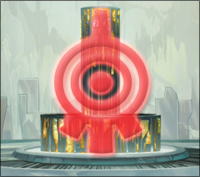 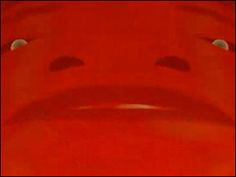 An unidentified enemy appearing in its avatar form.
An unidentified enemy appearing in its avatar form.
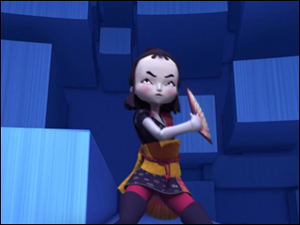 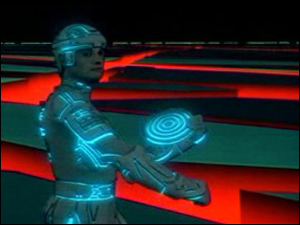 Throwing discs, ancestor of throwing fans?
Throwing discs, ancestor of throwing fans?
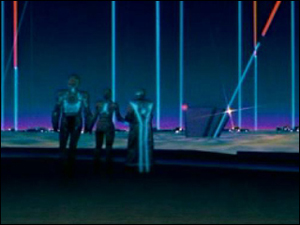 The MCP's activity is highlighted by a red colour. When it is destroyed, all the zones it used to control turn back to blue. Doesn't that remind you of the halos on certain towers?
The MCP's activity is highlighted by a red colour. When it is destroyed, all the zones it used to control turn back to blue. Doesn't that remind you of the halos on certain towers?
About the towers... In Tron, these are the only way programs can interact with the outside world. Oh! Doesn't that ring a bell?
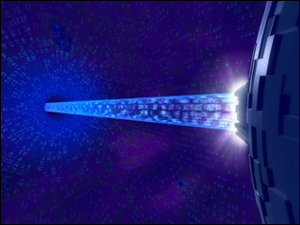 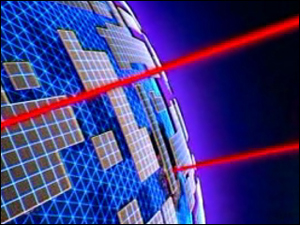 The luminous flux that they broadcast connect all the computers in the world together. Actually, those are data flow between computers; don't you remember the way Carthage is linked to the other Sectors?
The luminous flux that they broadcast connect all the computers in the world together. Actually, those are data flow between computers; don't you remember the way Carthage is linked to the other Sectors?
 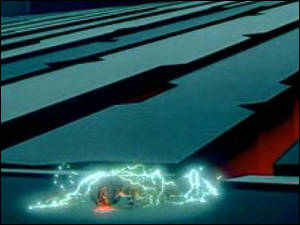 Be it in 1982 or in 2004, scratches will make you go through sizzling glitches!
Be it in 1982 or in 2004, scratches will make you go through sizzling glitches!
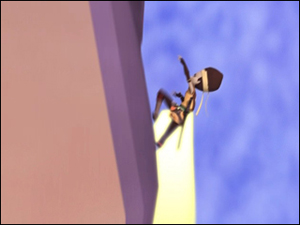 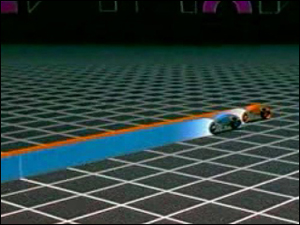 Going fast leaves a trail behind you, be you on a vehicle or on foot!
Going fast leaves a trail behind you, be you on a vehicle or on foot!
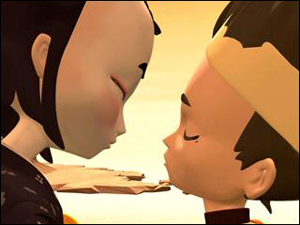 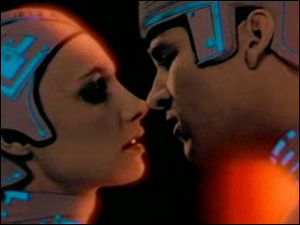 Not much love in the movie, but who could resist a lovely digital kiss?
Not much love in the movie, but who could resist a lovely digital kiss?
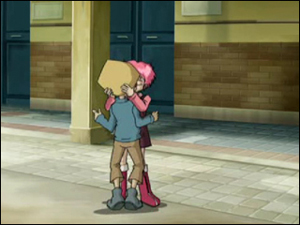 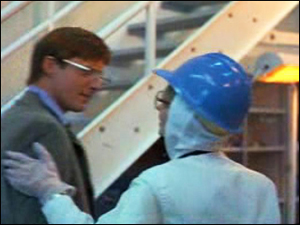 To hell with digital stuff! An IRL kiss, that's also beautiful!
And those two do remind me of Mr and Mrs Einstein, as far as their characters are concerned...
To hell with digital stuff! An IRL kiss, that's also beautiful!
And those two do remind me of Mr and Mrs Einstein, as far as their characters are concerned... |  | |
|  | Though at the beginning of the movie I felt somewhat sceptical, the more the story moved forward and grey areas were disappearing, the more common points I could find between Code Lyoko and Tron: there is a plethora of them, even more than with The Matrix!
I find it quite regrettable that this old Disney movie is not more widely known, because many Lyokophiles with a sharp, critical mind could enjoy watching this movie and see how much it inspired Code Lyoko.
To conclude, I'll say that Tron remains a movie of legacy, to connoisseurs, and that it inspired many other movies, books or even video games. Tributes and hints were and still are made, so you may find Tron even in a universe such as Kingdom Hearts 2!
Certainly, this file on Tron doesn't say everything there is to say on the movie because I had to stick to comparing it with Code Lyoko. If you want to learn more, Wikipedia may help you (you can see a whole list of science-fiction works it influenced), or, for Lyoko's sake, watch the movie! |  | |
File written by Shaka 23/10/07
|
 |
